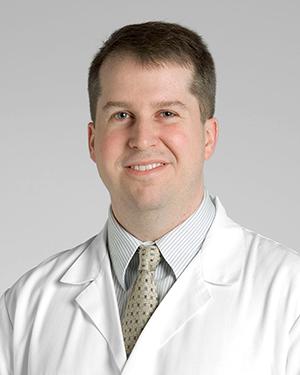Research News
09/06/2022
Dr. William Dupps, Jr. Receives $2.4 Million to Develop Advanced Imaging and Simulation Tools for Personalized Eye Care
Generating a virtual copy of the eyes to create personalized surgical plans will help lower operative risks and improve outcomes for patients with corneal disease.

Cleveland Clinic’s Cole Eye Institute has been awarded a four-year, $2.4 million grant from the National Eye Institute at the National Institutes of Health to research corneal optical mapping and fund the creation of patient-specific computer simulations. These simulations will be used to predict the risk of corneal disease development and progression, and surgical outcomes.
Led by William Dupps Jr., MD, PhD, Professor of Ophthalmology at the Cleveland Clinic Lerner College of Medicine and Professor of Biomedical Engineering at Case Western Reserve University, this study will address needs for better decision-making tools in laser refractive surgery and improved identification of corneal ectasia risk. Corneal ectasia is a disease that occurs when the load-bearing layers of the cornea become weak, causing the cornea to change shape and ultimately, distort vision.
Keratoconus is a naturally occurring form of ectasia that can be managed with rigid contact lenses in some patients but may require a corneal transplant as the condition progresses. Patients with an unrecognized predisposition for keratoconus who opt for refractive surgeries – such as LASIK, PRK or SMILE – to correct their vision run the risk of progressive loss of vision. Even patients with healthy corneal properties can end up with under- or over-corrected prescriptions after such surgeries due to normal variation in these properties, which are differences not currently measured or factored into treatment plans.
“There’s no one-size-fits-all approach,” Dr. Dupps says. “The shape and strength properties of the cornea in every patient are unique, and so surgery has to be tailored to each individual patient’s eyes. We believe there’s an opportunity to significantly enhance patient outcomes through personalization.”
Dr. Dupps and a team of scientists are studying how to provide the best patient outcomes by focusing their research on a new three-dimensional elastography technique for biomechanical mapping, combined with computer modeling to create “digital twins” of the eye.
“These digital twins are built using a custom Optical Coherence Tomography (OCT) elastography system to measure the shape and biomechanical properties of the patient’s eye,” says Dr. Dupps. “We then assemble a digital representation of the patient’s eye and manipulate the virtual model to simulate what SMILE, LASIK or PRK will do to the eye.”
Andrew Rollins, PhD, Professor of Biomedical Engineering at Case Western Reserve University, and Rafael Grytz, PhD, Associate Professor of Ophthalmology at the University of Alabama at Birmingham, will partner with Dr. Dupps on the development of the optical systems and cornea models required to create patient-specific simulations.
“This research will make it possible to quantify risks and predict outcomes, and then customize surgical plans accordingly for an individual patient,” Dr. Dupps says. “Our end goal is the creation of preoperative screening technology that helps us fine tune surgical corrections based on a patient’s individual biomechanics.”
Featured Experts
News Category
Related News
Research areas
Want To Support Ground-Breaking Research at Cleveland Clinic?
Discover how you can help Cleveland Clinic save lives and continue to lead the transformation of healthcare.
Give to Cleveland Clinic